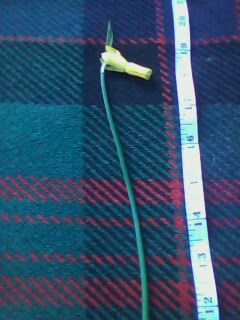 We have been to Sigüeiro (click here to see map) to see N. cyclamineus today. Hundreds in flower all along the Rio Tambre. This one had a stem 18 inches long. What a beautiful site (sight). They are clinging to the sandy river bank and straying into the fields behind. No N.bulbocodium in flower yet at this location, maybe some in a week or two.
We have been to Sigüeiro (click here to see map) to see N. cyclamineus today. Hundreds in flower all along the Rio Tambre. This one had a stem 18 inches long. What a beautiful site (sight). They are clinging to the sandy river bank and straying into the fields behind. No N.bulbocodium in flower yet at this location, maybe some in a week or two.
Lynne and Jan
Apart from the length of the stem, a typical Galician form of N. cyclamineus with its almost parallel sides to the corona, and no flare at the end, unlike the Southern Portugal form. While you are looking at the thousands that you are bound to see, could you examine them closely to check on the variability of the length of the style, because we have found several in the past which are longer than the trumpet, and many almost as long.
James
Yes, they are very typical Galician cyclamineus with their straight sided coronas and only very shallow fimbriation at the edge. The pictured flower’s style/stigma just protrudes from the end of the corona by about 1mm. I will check more plants on our next visit in a few days time James.
Jan & Lynne
Have you found any with two heads? We found one or two, and only a few bulbocodiums there. I’m envious!
Mary Lou
No, we haven’t found any N.cyclamineus with two heads as yet but I know there was a report in Flora and Sylva many years ago, that said a number of stems had been found in a large colony of several thousand plants, in an area around Vigo? I am not quite sure whether it was an article by Tait or possibly, Will Ingwersen on one of his many plant hunting forays. I will look it up when I get home and let you know Mary Lou. I doubt if those plants are still there now, whether it was Tait or Ingwersen, the areas around the big cities have been developed for housing, industrial estates and motorways so much in the last 20 years.
Fortunately, there are still a good number of quiet backwaters where the plant is surviving and thriving. Thank goodness. Jan & Lynne
The site where we found it was more in town. Coming into Sigueiro, we kept right at the circle toward Pto. Avieira, then right towards a refugio, and then left to the Rio Tambre. There was a picnic area and a weir in the river. I suspect the two-headed one left later that day. I did get a photo of it. Ten years ago, we found N. cyclamineus on the LU231 south out of Friol towards Palais de Rei, at the 11km marker, between the road and a small stream. Mary Lou